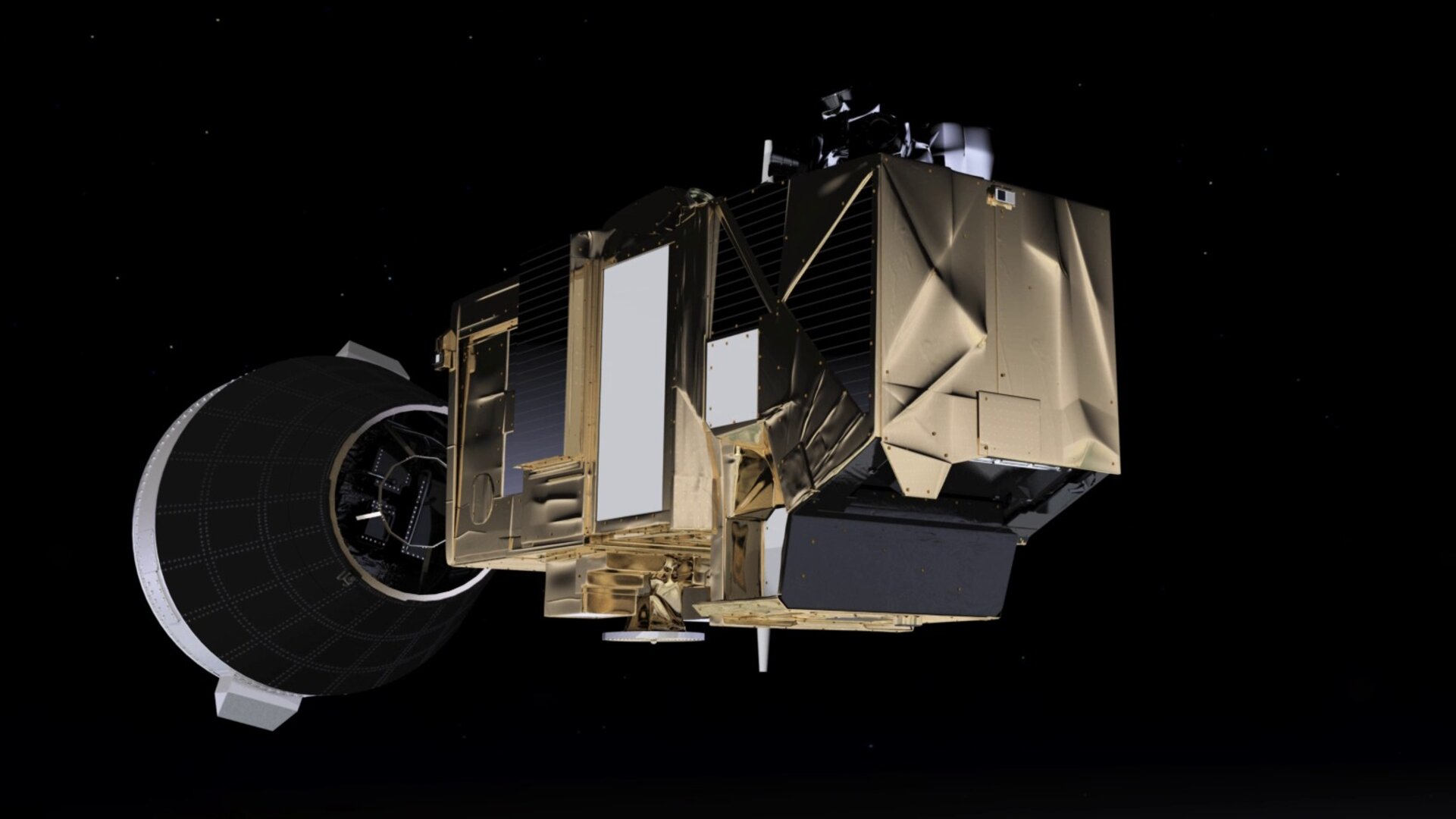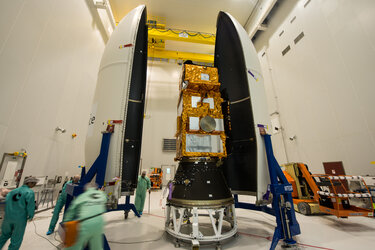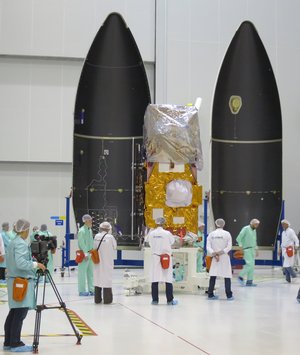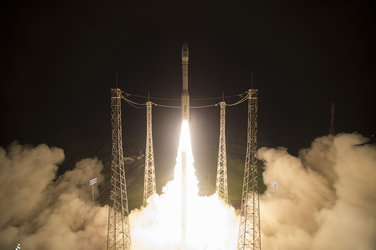Sentinel-2 launch timeline
On 23 June, a Vega launcher will loft the first of ESA's dual Sentinel-2 satellites into orbit from Europe's Spaceport in Kourou. For the mission control team, liftoff will mark the end of many months of careful preparations and the start of the mission's first critical phase.
At 1:51:58 GMT (3:51:58 CEST) next Tuesday morning, ESA's Sentinel-2A satellite is set to launch from Kourou on a 30-m tall Vega rocket for a raucous ride into space on a mission dedicated to Europe’s Copernicus environmental monitoring programme.
Once operational, this new satellite will provide information for agriculture and forestry and for helping manage food security. It will also provide timely information on pollution in lakes and coastal waters. Images of floods, volcanic eruptions and landslides will contribute to rapid disaster mapping and humanitarian relief efforts.
About 55 minutes after lift-off, the Sentinel-2A satellite will separate from Vega's AVUM upper stage and soar free into orbit, marking the start of the approximately three-day long LEOP – the critical Launch and Early Orbit Phase.

Upon separation, Sentinel-2A will automatically activate its solar array and transmitter, orient itself into an Earth-pointing mode, and start transmitting 'telemetry' – onboard status signals – to the ground.
In Darmstadt, Germany, the mission control team at ESA's space operations centre will have followed the liftoff intently, waiting for ESA's ground station in Perth, Australia, to receive the first radio signals from space. The critical acquisition of first signals (AOS) is expected about 55 minutes after launch.
Once contact has been established, the team will assume control of the new spacecraft, working around the clock to activate crucial onboard systems and ensure the spacecraft’s health in the extreme environment of space.
The first orbital manoeuvre – a burn using the spacecraft's thrusters – is planned around 51 hours into the mission.
Watch live
The lift off will be streamed live via two separate programmes on Tuesday.
- Sentinel-2 launch event live from the ESOC operations centre, 01:00 GMT (03:00 CEST) start
- Launch webcast live from Kourou, 01:30 GMT (03:30 CEST) start
19 June at Kourou: Launch rehearsal review (RAL) - decision for VV05 flight
19 June at ESOC: Final 'dress rehearsal' for Mission Control Team
Timeline below is forecast only and all times are subject to change. See abbreviations at bottom of page. Access an expanded version via ESA's EO Launch Campaign blog.
22/23 June
| MET | UTC/GMT | CEST | VV05 | S2/ESOC |
| -08:00:00 | 17:51:58 | 19:51:58 | Start of launcher activities on launch pad in Kourou | B-Section of Mission Control Team on console in ESOC MCR; start of pre-launch activities in MCR |
| -07:45:00 | 18:06:58 | 20:06:58 | Start of Vega countdown | |
| -07:40:00 | 18:11:58 | 20:11:58 | Establish data link from spacecraft to ESOC via umbilical cable | |
| -07:00:00 | 18:51:58 | 20:51:58 | Start of spacecraft switch on; check telemetry flow between spacecraft and ESOC | |
| -06:51:00 | 19:00:58 | 21:00:58 | Synchronization of on-board clock with Universal Time (UTC) | |
| -06:30:00 | 19:21:58 | 21:21:58 | Activation of on-board computer and loading of flight program; Activation of telemetry transmitters | |
| -06:00:00 | 19:51:58 | 21:51:58 | Start of ESOC network countdown - team now conducts periodic spacecraft health checks | |
| -05:45:00 | 20:06:58 | 22:06:58 | Mobile gantry door opening | |
| -03:00:00 | 22:51:58 | 00:51:58 | Mission Control Team starts to configure spacecraft for launch | |
| -03:10:00 | 22:41:58 | 00:41:58 | Mobile gantry withdrawal (ca. 45 min) | |
| -02:20:00 | 23:31:58 | 01:31:58 | ESOC FD confirms to Kourou LCC ground segment ready for launch | |
| -02:16:00 | 23:35:58 | 01:35:58 | Mission Control System at ESOC switched to launch configuration | |
| -02:00:00 | 23:51:58 | 01:51:58 | A-Section of Mission Control Team on console in ESOC MCR | |
| -01:30:00 | 00:21:58 | 02:21:58 | Initial GO/NO-GO roll call at ESOC | |
| -01:20:00 | 00:31:58 | 02:31:58 | Activation of transponders | |
| -01:05:00 | 00:46:58 | 02:46:58 | ESOC FD confirms GO status with all ground stations | |
| -00:52:00 | 00:59:58 | 02:59:58 | Final GO/NOGO roll call at ESOC | |
| -00:45:00 | 01:06:58 | 03:06:58 | ESOC FD confirms GREEN for launch to Kourou LCC | |
| -00:34:00 | 01:17:58 | 03:17:58 | Launcher system ready | |
| -00:10:00 | 01:41:58 | 03:41:58 | Last weather report prior to launch | Sentinel-2 on internal power |
| -00:04:00 | 01:47:58 | 03:47:58 | Start of Vega synchronized sequence | |
| -00:00:30 | 01:51:28 | 03:51:28 | Activation of automatic sequence | |
| -00:00:08 | 01:51:50 | 03:51:50 | Last possible launch abort | Last possible launch abort |
| 00:00:00 | 01:51:58 | 03:51:58 | Vega P80 IGNITION | |
| 00:00:01 | 01:51:59 | 03:51:59 | LIFT OFF | |
| 00:01:52 | 01:53:50 | 03:53:50 | Separation of first stage (P80) | |
| 00:03:37 | 01:55:35 | 03:55:35 | Separation of second stage (Zefiro-23) | |
| 00:03:54 | 01:55:52 | 03:55:52 | Jettisoning of fairing | |
| 00:06:31 | 01:58:29 | 03:58:29 | Separation of third stage (Zefiro-9) | |
| 00:07:42 | 01:59:40 | 03:59:40 | AVUM first burn | |
| 00:16:08 | 02:08:06 | 04:08:06 | AVUM shutdown | |
| 00:51:46 | 02:43:44 | 04:43:44 | AVUM second burn | |
| 00:53:52 | 02:45:50 | 04:45:50 | AVUM second shutdown | |
| 00:50:29 | 02:42:27 | 04:42:27 | Earliest AOS Vega at Perth station | |
| 00:54:43 | 02:46:41 | 04:46:41 | SEPARATION | S2 separates from AVUM upper stage |
| 00:55:20 | 02:47:18 | 04:47:18 |
Earliest AOS S2 - Acquisition of signals from S2 - ESOC team starts status & health checks |
|
| 01:04:55 | 02:56:53 | 04:56:53 | Earliest possible solar array deployment (ca. 3 min) | |
| 01:23:09 | 03:15:07 | 05:15:07 | Latest expected solar array deployment complete | |
| 01:43:35 | 03:35:33 | 05:35:33 | AVUM third burn | |
| 01:44:04 | 03:36:02 | 05:36:02 | AVUM shutdown |
LCC - Launcher Control Centre (Jupiter Control Room, Kourou, French Guyana)
ESOC- European Space Operations Centre, Darmstadt, Germany
MCR - Main Control Room at ESOC
PER - Perth tracking station, Australia
FD - ESA Flight Director in Main Control Room
VV05 - Vega launcher flight VV05
MET - Mission Elapsed Time (before/after liftoff times are -/+)
S2 - Sentinel-2A spacecraft
AOS - Acquisition of signal
LOS - Loss of signal

















